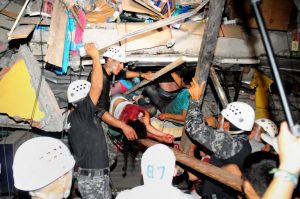
At least 41 people were killed when a powerful 7.8-magnitude earthquake struck Ecuador, destroying buildings and sending terrified residents dashing from their homes, authorities said late on April 16.
/ AFP PHOTO / API AND AFP PHOTO / Ariel Ochoa
by Paola Lopez
QUITO, Ecuador (AFP) — At least 77 people were killed when a powerful 7.8-magnitude earthquake struck Ecuador, destroying buildings and a bridge and sending terrified residents scrambling from their homes, authorities in the Latin American country said Sunday.
Vice President Jorge Glas said the death toll will likely rise further in what he called the “worst seismic movement we have faced in decades.”
The quake, which struck at 2358 GMT Saturday about 170 km northwest of Quito, lasted about a minute and was felt across Ecuador, northern Peru and southern Colombia.
“Oh, my God, it was the biggest and strongest earthquake I have felt in my whole life. It lasted a long time, and I was feeling dizzy,” said Maria Torres, 60, in the capital Quito, which was rocked by the late Saturday quake.
“I couldn’t walk… I wanted to run out into the street, but I couldn’t.”
Glas said early Sunday that the number of confirmed deaths has reached 77, and that more than 588 people were injured.
“We know that there are citizens trapped under rubble that need to be rescued,” he said in a special TV and radio broadcast.
Officials declared a state of emergency in the six worst-hit provinces.
Police, the military and the emergency services “are in a state of maximum alert to protect the lives of citizens,” Glas said.
President Rafael Correa, on a visit to the Vatican, wrote on Twitter that he was immediately returning to Ecuador.
In the Pacific port city of Guayaquil, home to more than two million people, a bridge collapsed, crushing a car beneath it, and residents were picking through the wreckage of houses reduced to heaps of rubble and timber, an AFP photographer reported.
Ecuador’s Geophysical Office reported “considerable” structural damage “in the area near the epicenter as well as points as far away as Guayaquil.”
– Earthquake zone –
The US Geological Survey (USGS) said the 7.8-magnitude shallow quake struck off the northwest shore of Ecuador, just 27 kilometers from the town of Muisne. The vice president gave a slightly lower measurement of magnitude 7.6.
Ecuador lies near a shifting boundary between tectonic plates and has suffered seven earthquakes of magnitude 7.0 or higher in the region of Tuesday’s quake since 1900, the USGS said. One in March 1987 killed about 1,000 people, it said.
At least 55 smaller aftershocks rattled the country after the main quake, Glas said.
The Hawaii-based Pacific Tsunami Warning Center initially issued a warning for the nearby Pacific coastline but later said that the threat had largely passed.
– ‘Severe damage’ –
Miriam Santana, a 40-year-old resident of the western city of Manta, described scenes of devastation.
“It was as if the world was about to end,” she told AFP by phone. “Homes were coming down — around my house three homes collapsed, and street lights fell.”
“There are people trapped under the rubble,” she said, adding that locals were in a state of “total desperation.”
Authorities closed the city’s airport, saying the control tower suffered “severe damage.”
In northern Quito, people ran out of their homes in terror as power lines swayed back and forth, knocking out power to some areas. Media images showed pictures of damaged shops.
Cristina Duran, 45, grabbed her three pets and stood under a large doorway to avoid shards of glass falling from shattered windows.
“I was frightened. And I just kept asking for it to be over,” she told AFP.
President Correa, interviewed by phone on Radio Publica, called for “calm and unity.”
Correa said that rescue teams were flying in from Mexico and Colombia to help search for quake victims, and he expressed solidarity with the families of the deceased.
– Shock and panic –
At Guayaquil airport, passengers awaiting flights ran out of the terminals when they felt the ground shake.
“Lights fell down from the ceiling. People were running around in shock,” said Luis Quimis, 30, who was waiting to catch a flight to Quito.
Guayaquil resident Carlota Lopez said that she was in a car when the earthquake struck.
“The power lines were swaying wildly, and I was afraid that the lines or the street lights would fall on the car,” she told AFP by phone.
Lopez said it felt “as if the car was being shaken with great strength” by people outside the vehicle and that there was a power outage immediately afterwards.
The quake was also felt in northern Peru and a large section of southern Colombia, according to authorities in those countries, although no casualties were reported. Peruvian officials however urged coastal residents to stay away from the beach.
https://youtu.be/0U7UNXy2GAA
© 1994-2016 Agence France-Presse








